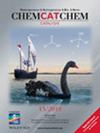The effect of dithionite and its decomposition products on redox mediators used in the cyclic voltammetry of nitrogenase enzymes
IF 3.8
3区 化学
Q2 CHEMISTRY, PHYSICAL
引用次数: 0
Abstract
Cyclic voltammetry is a powerful tool to study enzyme mechanisms. Over the last decade voltammetry has been applied to probe aspects of nitrogenase catalysis. One aspect that is often overlooked is the effect of dithionite (S2O42-, DTH) that is routinely added to purification and storage buffers to protect nitrogenase and anaerobic enzymes alike (e.g hydrogenase) from oxygen. Dithionite has extremely complex chemistry with a myriad of decomposition products. Here we sought to systematically investigate the effect of dithionite and some of its decomposition products on the voltammetry of different redox mediators independently and in conjunction with nitrogenase. We found the major decomposition product sulfite (SO32-) gives rise to reductive catalysis, which cannot be distinguished from enzyme catalysis, particularly with cobaltocenium mediators. We provide recommendations on how to identify and avoid interpreting ‘pseudo’ catalysis in lieu of enzyme catalysis by DTH and reinforce the requirement to remove DTH prior to performing cyclic voltammetry experiments.连二亚硫酸盐及其分解产物对用于氮酶循环伏安法的氧化还原介质的影响
循环伏安法是研究酶机制的有力工具。在过去的十年中,伏安法已被用于探测氮酶催化的各个方面。其中一个经常被忽视的方面是连二亚硫酸盐(S2O42-,DTH)的影响,连二亚硫酸盐通常被添加到纯化和储存缓冲液中,以保护氮酶和厌氧酶(如氢酶)免受氧气的影响。连二亚硫酸盐的化学性质极其复杂,分解产物不计其数。在此,我们试图系统地研究连二亚硫酸盐及其一些分解产物对不同氧化还原介质伏安法的影响,包括独立影响和与氮酶结合影响。我们发现,主要分解产物亚硫酸盐(SO32-)会产生还原催化作用,而这种催化作用无法与酶催化作用区分开来,尤其是在钴硒介质中。我们就如何通过 DTH 识别和避免解释 "伪 "催化作用以代替酶催化作用提出了建议,并强调了在进行循环伏安法实验之前去除 DTH 的要求。
本文章由计算机程序翻译,如有差异,请以英文原文为准。
求助全文
约1分钟内获得全文
求助全文
来源期刊

ChemCatChem
化学-物理化学
CiteScore
8.10
自引率
4.40%
发文量
511
审稿时长
1.3 months
期刊介绍:
With an impact factor of 4.495 (2018), ChemCatChem is one of the premier journals in the field of catalysis. The journal provides primary research papers and critical secondary information on heterogeneous, homogeneous and bio- and nanocatalysis. The journal is well placed to strengthen cross-communication within between these communities. Its authors and readers come from academia, the chemical industry, and government laboratories across the world. It is published on behalf of Chemistry Europe, an association of 16 European chemical societies, and is supported by the German Catalysis Society.
 求助内容:
求助内容: 应助结果提醒方式:
应助结果提醒方式:


